I’ve been lucky enough to work with the best hockey players on the planet in my time working in the National Hockey League. Now, it’s my mission to help deliver the same type of training that helped those players stay fast and strong to anyone and everyone that is willing to put in the work. I recently launched an online training option so that I can reach and impact hockey players around the globe and you can actually sign up below.
“Bantam Back” is a description of a lumbar stress fracture in youth hockey players. For those unfamiliar, Bantam refers to hockey players ages 13-15 years old. Basically, it is Spondyloylsis which is a stress fracture in the pars interarticularis of the lumbar vertebrae which is a small bone joining 2 vertebrae. These fractures can happen from repetitive stress.
Unfortunately, this condition has been popping up frequently in recent years. I first heard of this condition from John Bottoms, a Minneapolis based Physical Therapist. The frequency of how many kids are in his clinic for this shocked me. What can strength and conditioning coaches do during the reconditioning process and what can they do to help prevent them from happening in the first place?
https://orthoinfo.aaos.org/en/diseases–conditions/spondylolysis-and-spondylolisthesis/
From my personal observation, the typical Bantam Back individual is a longer/taller player. They also may have recently had a growth spurt. I imagine it could happen with shorter players but from what I have seen, they’ve been on the taller side. They also play hockey on a year-round basis.
Although I do think that repetitive rotation in shooting is a contributing factor, I also believe that improper skating technique contributes. Specifically, when skating mechanics break down (“bag” skating or punishment skating after practices). This is where players can become more straight-legged versus maintaining a proper back position and knee bend. I also believe that there is an inability for coaches and players to determine the proper depth and technique for skaters. I think we can get confused when teaching taller players to get low while skating. For example, a taller player may not look low in comparison to smaller players. However, when you take hip and knee angles into consideration, they may be closer than you think. I believe that the stress in the back is higher for taller players who maybe coached to get lower. When you add in repetitive and useless conditioning drills- the outcome isn’t good.
The prescription when diagnosed with Bantam Back is 3 months of no activity. However, physical therapy can begin during that time. This is crucial so that the fracture can heal while also removing any activities that may have helped caused the injury in the first place. In the recovery process, the no activity prescription is strict. Some orthopedic specialists may recommend a back brace during the 3 months.
What can happen is that people don’t listen to the doctor’s advice. Maybe the player is diagnosed during the competitive season? Maybe a showcase that is heavily scouted is coming up? It doesn’t matter. The 3 months off is key. I understand that this isn’t good news but I look at it as a time to reset and refocus on some things before returning to the ice. The payoff is bigger in the long run.
The treatment plan at the beginning consists of low level core exercises and stretches specifically for the hamstrings and hip flexors. The progression gradually becomes challenging from low level to more functional applications so that the player can return to the ice. Usually, the rehabilitation combined with the 3 months of rest results in a positive outcome.
What can Strength and Conditioning Coaches do to help these situations and what can they do to help prevent from them happening?
Although I don’t think it is appropriate, year-round hockey is normal nowadays. Players have more opportunities to play outside of the winter hockey season. It is important to participate in other sports and/or recreational activities. I think that the time off the ice and away from hockey is important. When I think about the professional players that I get to work with, they take a minimum of 1 month off of the ice when the season ends. When they do return to the ice, the intensity and duration is progressed over the next few months up until training camp. Bantam aged players are not professionals. Their bodies are still maturing. I think the 3-month activity is a blessing for those who suffer from bantam back.
When it comes to exercises and progressions, I think it’s important to note that I am not a Physical Therapist (PT). I do help with the reconditioning of athletes. I also use exercises that PT’s will use with injured athletes with the healthy athletes that I work with. I truly believe that if a PT prescribes exercises with an injured client, why wouldn’t I want to prescribe exercises with a healthy athlete to help prevent injuries? Whether it is core exercises, pre-habilitation, or functional training- I really don’t care. As long as what we are doing is working and we are simultaneously getting faster, powerful, and stronger.
Where I think the Strength and Conditioning Coach is important is in the return to play phase and then helping the player with preventing this from happening again. When it comes to program design, I think that some modifications need to be made. Avoiding exercises that could promote hyperextension of the lower back while under load could help as well as avoiding axial loading. For example, back squats, front squats, overhead pressing, deadlifting, and Olympic lifting would be discontinued. I do think that there are many ways for an athlete to get more powerful, stronger, and faster without risking further injury.
The Mcgill Torso Muscular Endurance Test Battery (1) is used as an assessment to measure endurance in the trunk flexors, lateral endurance (side bridge), and the back extensors. This can be used as a baseline measurement at the beginning of rehab. During the course of the 3 months, this can be reassessed to see progress.
When it comes to core training, I do think improving performance of the Mcgill Torso Muscular Endurance Test Battery helps. McGill’s Big 3 (2) is a really good safe and simple way to increase not only performance in the Endurance test, but also a way to build a strong and stable back with endurance capabilities. We’ve removed what others refer to as traditional core training and have since been incorporating the Trunk Curl Up, the Side Bridge, and the Bird Dog as well as Glute Bridges for our floor-based exercises.
TRUNK CURL UP
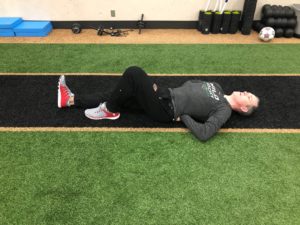
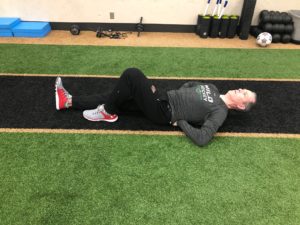
SIDE BRIDGE
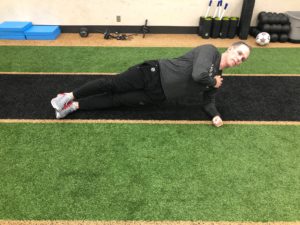
BIRD DOG
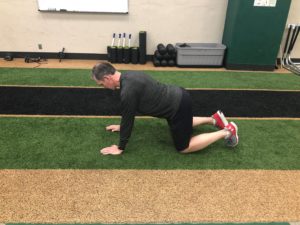
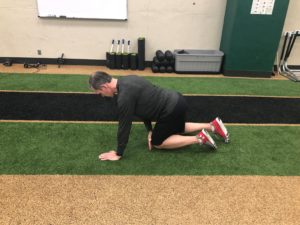
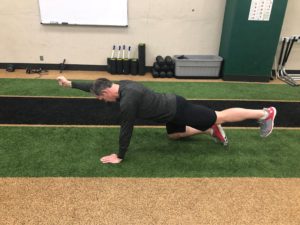
What about Skating? As I mentioned before, I believe that less than adequate skating technique can contribute to Bantam Back. I think that after the 3-month long break, the player needs to be with a good skating coach to help the player possibly re-learn skating technique. The fundamental position of skating needs to be emphasized so that lower back health isn’t compromised. This combined with proper strength and conditioning off the ice can contribute to the player returning back to their normal level of play. I have personally seen kids come back to skate and play again at a higher level.
Again, sometimes an injury like this can be a blessing in disguise. It may sound crazy, but it is 3 months forced rest. Unfortunately, some kids need that today. A young athlete competing year round combined with less attention to technique can be as a recipe for something like this.
- https://www.acefitness.org/cmes-resources/pdfs/02-10-CMES-McGillsTorsoEnduracneTest.pdf
- https://www.livestrong.com/article/392341-stuart-mcgills-big-three-back-exercises/
As I am working in my 18th year with a professional hockey franchise, I want to share my thoughts on working with a team. There are lots of perceptions and outside opinions from others on the way that things should be done. However, I think that when you do have experience, I think you can have a reason for doing some of the things the way that you do.
Earlier in my career, I worked with collegiate hockey teams. I would train the team as one group. This would mean that every player is doing the exact same program. However, individual modifications and regressions have always been made to certain exercises for certain individuals. These changes were made based on the athlete’s requirements. Most of the time this may have been due to a previous or a current injury that would prevent the athlete from doing what other team members were doing. This was done on a year-round basis. When I entered the professional environment, I kept that same philosophy. The reality is that I still do today.
There has been some criticism of this in the past from some athletes and other professionals. “Why am I doing the same program as him?” or “Shouldn’t each player have their own program?”. When I think of the individual needs of athletes, why does one athlete need more of something while another needs less- in-season? Sure, there are individual needs to be met with some of our results of measurements that we administer. Also, we do have athletes who do something in addition to our template, but the template is still the template for the team.
Today, the majority of my work with our athletes is done in-season. This is due to the fact that professional athletes aren’t required to do what the team provides them with during the off-season. We have some athletes who will follow our program. However, most of them hire their own personal trainers for the off-season. In-season is entirely different.
In season, we train as a team. This includes warm ups and strength training workouts. I believe that there is a benefit to teammates working together- both on and off- the ice. The way I always look at it is that I want to decrease the chance of injuries and increase performance the best that I possibly can. Given the logistics of the professional hockey schedule, there are always going to be challenges. To me, putting together the template is part of the art of coaching. Our workouts are quick and efficient, especially post-game when our athletes’ time is valuable.
Some of the best players that I have been fortunate to work with didn’t/don’t necessarily enjoy strength and conditioning. What I have found is that the good and great ones don’t necessarily have to enjoy it but they understand the “Why” and embrace it.
When the leaders and your best players on your team understand the importance of why they are training, then it is easy for the rest of the team to understand as well. The more time we can train as a team is better for us in the long run.
I wrote this a while back and it was posted on StrengthCoach.com. I may post some others that aren’t on this site.
The goals of the pre-season strength and conditioning phase for hockey are 1- To help prepare for the demands of training camp and 2- To bridge the gap between the off-season and in-season strength and conditioning phases. At the collegiate and professional levels, this is a unique time for the Strength and Conditioning Coach because it is when most of the players are present for strength and conditioning sessions. With the fact that many athletes could be in different locations throughout the off-season, this a great time to get the entire team together and implement the program and help build team camaraderie.
The pre-season phase is usually 3-4 weeks in duration and occurs from late August through early September. We will spend 3 days in the weight room and 4-5 days on-ice on a weekly basis. Strength training will take place prior to skating on Monday, Wednesday, and Friday while conditioning on the bike is completed prior to skating on Tuesday and Thursday. Skating is Monday through Friday.
During this phase, more volume is implemented. This is much different from the early off-season phase when training is primarily off-ice. Some of the training methods that were done in the off-season will be discontinued. This includes running and slideboarding. The conditioning focus is on-ice speed and conditioning with the exception of 2 bike workouts per week.
Strength Training
The strength training philosophy during this period will consist of circuit training. This is different from any other time of year. Instead of doing 5-6 strength and power exercises, we will now do 12 exercises straight through. When the circuit starts, the rest periods between exercises will be determined by how many athletes are present. For example, if there are 24 athletes, we will partner up at each exercise and go at a simple I go-you go pace. Each athlete and partner is assigned an exercise/station from 1-12 and then they will follow along. There is a 1 minute and 30 second rest period when the circuit is completed.
I have found that putting the exercises in this order has worked best: double leg push, upper pull (vertical), upper push (horizontal), core/anterior chain, lower explosive, 1-Leg lower push, upper pull (horizontal), upper press (vertical), 1-leg lower (glute/hamstring emphasis), 1-arm upper pull, core/stabilization, and upper explosive. We will perform these circuits 2 x per week on Monday’s and Friday’s. The difference between the Monday and Friday circuit is that although the format of movements will stay the same, the selection of exercise will be different. For example, on Monday we may perform a pull up (hands facing away) while we may perform a chin up on Friday (palms facing). On Wednesdays, we will perform a plate circuit which is borrowed/stolen from Strength and Conditioning Coaches Mike Boyle and the Calgary Flames’ Rich Hesketh.
During the Monday and Friday circuits, each player will perform the prescribed number of reps for each exercise in the circuit. Regressions are implemented for athletes who may not be able to perform a specific exercise due to reasons such as past injuries and/or biomechanical deficiencies. For example, we may substitute a goblet squat for the front squat or a split squat instead of the 1-leg squat.
During the Wednesday circuit, each player will be given a 35-lb plate and complete the entire circuit without resting. This will take place for each exercise until the steering wheel exercise in which all of the athletes perform it together.
Conditioning
The off-ice conditioning will take place on the stationary bikes Tuesdays and Thursdays. On Tuesdays, the bike sessions will consist of 1-minute sprints at a high level of resistance. During these sprints, we are trying to enhance the player’s resistance to fatigue- especially after the 30-40 second mark in which the average hockey shift ends. At the end of the sprint, they will recover to 130 bpm while at level 1 on the bike. We will start with 6 reps in week 1 and add one more rep each week. On Thursdays, we will simply perform a steady state/cardiac output ride where the emphasis is on keeping the heart rate in the 130-140bpm range. This ride is to help increase cardiac output and enhance our ability to recover. We will typically go for 30-60 minutes. Saturday bike rides will be prescribed based on how the player feels and what his needs may be.
On the ice, the players will run their own practices. They will perform 45 minutes of drills and then follow up with a 45 minute scrimmage. On Fridays during the preseason, players prepare for the training camp conditioning test at the end of practice. The conditioning test is very demanding and requires serious preparation. Not only do the players get prepared for the test, but they are getting some conditioning work in during the process.
What I really like about pre-season workouts is that there is full participation from everyone on the team. The players believe in the program and the importance of training together for team building. This is a great phase because it can help establish the culture of the strength and conditioning program prior to the in-season phase. The Strength and Conditioning Coach can coach and interact with the athletes while making a smooth transition into the in-season phase.
As I continue my career in professional hockey, the process of getting your athletes to buy in and participate in the program is much more important than providing them with a “state of the art” program that not everyone will want to do. I believe that when you provide them with a basic program in an environment where they are training hard together, the results can be positive from an on-ice perspective.
Here is a link to a recent podcast that I did with Steve Breitenstein from TCBoost Sports Performance:
https://itunes.apple.com/us/podcast/the-speed-podcast/id1333698295?mt=2
I had fun participating. I hope you enjoy it!
This is another phase 1 exercise. I like this because it allows us to get shoulder and arm work done with one exercise versus performing dumbbell curls and shoulder presses individually.
– The athlete is tall with their hips extended.
– The arms must be long at the start of the curl and the wrists are nuetral during the presss.
– I’ve found that the nuetral grip helps allow us to get a better anatomical position with less back extension and the pressing path in line with the ears.
This is phase 1/Accumulation phase exercise that we do for horizontal pressing.
I’ve always like these because it allows us to get unilateral work in with dumbbells while also getting some shoulder stabilization work.
Week 1 we will start with 8 reps each side and progress 2 reps each week. Ideally, we try to increase the load as well. I feel that this allows for a smooth transition to barbell work in phase 2.
We like to incorporate stretches to muscle groups that can be tight from prolonged sitting and simply playing the game of hockey. We will stretch within our strength training sessions to ensure that stretching doesn’t become an afterthought and to utilize the rest periods in between sets of strength training exercises.
A muscle group that can become tight and restricted is the Quadriceps (more specifically the Rectus Femoris, Vastus Intermedius, Vastus Medialis (VMO), and the Vastus Lateralis).
Years ago, I read this article by Charles Poliquin Question of Strength 22. I’ve been using this variation ever since. I’ve found more benefit with the addition of foam rolling the quads prior to this stretch.
Here is a short video that I did about Push Ups. I see many variations of push ups when I start working with youth athletes. Here are some methods that have worked to help push ups look better and get the full benefit of the exercise.
I am trying to wake my blog up from a period of inactivity. Here is something I wrote 6 years ago and was still in the “draft” category. When I re-read it and think about what I think now- If I was training a team in the off-season, I still believe in this.
We use traditional exercises to build both strength and power with our athletes. One way we look to increase total body power is by performing Olympic lift variations. We will utilize lifts such as the Hang Clean, Hang Snatch, and Dumbbell Snatch for the purpose developing hip and leg power. In these types of lifts, we are actually borrowing the methods from what you may see at the Olympic Games where the Clean and Jerk and the Snatch are the competitive lifts. Olympic lifters are some of the most powerful athletes in the world. Athletes can benefit from the same methods that develop power in the Olympic lifters. However, unlike the Olympic lifters who pull the barbell from the floor, we modify them by performing them from the hang position.
As I progressed in my career as a Strength and Conditioning Coach, I was exposed to Olympic lifting both from the hang position and from the floor. While working in environments where athletes lifted from the floor, I always knew what I would do when I was able to design my own programs. In the back of my mind, I knew that my athletes were going to do Olympic lift from the hang position. The reason is that I had seen far less inadeuqatge form from the hang position versus from the floor. I never saw the benefit of lifting from the floor versus the hang position. To me, the perceived benefit of lifting from the floor simply wasn’t worth the risk of potential injury.
In the hang position, the chest is up, the hips are back, and the shoulders are in front of the bar, with the wrists rolled under. All we are asking the athlete to do is jump, shrug, and sit to get to the front squat rack position. Pretty simple to do, but like any other exercise, it does take some coaching.
When we perform power exercises such as Olympic lift variations, we will do them twice per week during the off-season and 1-2 times per week in-season. In the off-season, we spend 1 of those days performing the Hang Clean, while on the other day, we are either doing Dumbbell Snatches or Kettlebell Swings.
In the last few years, I have strayed away from the Hang Snatch. Now, I believe that they are in the must-do category. When it comes to the reasons why we don’t Hang Snatch, I have always thought of these:
– When I think of hockey players, I immediately think of the sport demands. Hockey isn’t an overhead sport so why should we use overhead lifts for a sport in which they never have their arms overhead?
– I am afraid of my athletes suffering injuries in the weight room. In the case of Hang Snatch, my primary concern here are shoulder injuries. I don’t like the wide grip position on Hang Snatches. I think we would be asking for trouble if we did large amounts of volume with that version.
– The Hang Snatch is a technical lift. I would not be 100% comfortable with the players following our program at home by themselves. The reality is that most of our players leave the area during the off-season.
Now that I have given a few reasons why we don’t Hang Snatch, a recent training session with one of my athletes has let me know that I could also look at why it is a great exercise. In this situation, the athlete had been training around a previous back injury for the past 2-3 years. One off-season, I discontinued the Hang Clean and several other double leg squatting and hinging exercises for this guy. We inserted alternatives such as Squat Jumps and Vertimax Jumps for power development. At the beginning of this past off-season, we discussed what he liked to do for explosive exercises. Immediately, he said he wanted to Hang Snatch. When I was done watching him perform a set, I said “Why did I stop doing these with my athletes?”
What did I see that was so good? I saw an exercise that was really hard to do wrong- once you got into the proper start position. These are the types of exercises that I really like- simple and effective with limited risk of injury with proper load. In this situation, he picked up the bar and slid it down to the position above his knees while simultaneously pushing his hips back. At the same time he had an arched back, his hands were rolled over the bar, his chest and shoulders were over the bar, and his hands were a tad wider than shoulder width and his eyes were up. From there, he proceeded to jump, shrug, and sit while extending the arms up in the finished position. It was really good technique.
Looking at the reasons I gave above for not using the Hang Snatch, I simply thought of the opposite of the reasons to determine why I would use them again.
Hockey is indeed not an overhead sport. However, I see the benefit of the Hang Snatch for the sport. Finishing the lift while holding the bar overhead under load is a great way to train the scapula-thoracic and rotator cuff musculature as stabilizers. The Hang Snatch is also a good exercise for hypertrophy and strength, specifically in the upper back and posterior shoulder girdle region. More importantly, although the load is lower than in the Hang clean- the velocity is higher in the Snatch. Every athlete who is trying to improve power and who don’t have physical limitations. However, like any other exercise, there are some athletes who should not do them at first. For example, we don’t use the Hang Snatch with athletes who have shown asymmetries on the shoulder mobility part of the Functional Movement Screen. We will try to correct the asymmetries with corrective exercise strategies with these individuals. Once they can demonstrate symmetrical scores, we would start teaching them the Hang Snatch.
In regards to load selection during the Hang Snatch, lighter is OK. Especially at the start when we are learning. The proper start position along with the movement has to be dialed in. Like any other exercise in our program, we will add weight to the bar progressively as the athlete gets stronger.
Like I mentioned, the Hang Snatch can be a great exercise for power development. If I can prescribe an exercise that requires less load and can be done right, I am all for it.
